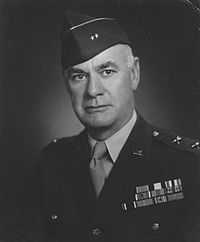Fred L. Walker
| Fred Livingood Walker | |
|---|---|
 | |
| Born |
June 11, 1887 Fairfield County, Ohio |
| Died |
October 6, 1969 (aged 82) Washington, D.C. |
| Allegiance |
|
| Service/branch |
|
| Years of service | 1911 - 1946 |
| Rank |
|
| Commands held |
|
| Battles/wars |
Pancho Villa Expedition
|
| Awards |
Distinguished Service Cross (2) Distinguished Service Medal Silver Star Purple Heart (2) |
Fred Livingood Walker (June 11, 1887 – October 6, 1969)[1] was a highly decorated American military officer with the rank of Major General, who served in two World Wars and was awarded with second highest military decorations in both wars, Distinguished Service Cross. During the World War II, Walker commanded the 36th Infantry Division[2] in Italian Campaign.
Early life
Fred Livingood Walker was born on June 11, 1887 in Fairfield County, Ohio as a son of William Henry Walker and his wife Belle (néé Mason). Young Fred attended the Ohio State University and graduated in 1911 with a diploma from engineering. Subsequently he was accepted to the Army and commissioned with the rank of Second lieutenant of Infantry. He served briefly with an Infantry unit in Fort Sam Houston in San Antonio, Texas and then he was transferred to the Philippines, where he served with the 13th Infantry Regiment.
In 1914, he was transferred back to the United States, where he was stationed in Eagle Pass, Texas and also took a part in Pancho Villa Expedition under the command of general John J. Pershing.
With the United States entry into the World War I, Walker went overseas and served with the 30th Infantry Regiment in France. Major Walker commanded the battalion of his regiment during the Second Battle of the Marne in the summer of 1918 and distinguished himself during the heavy combats. In July 1918, Walker received Distinguished Service Cross for his service during the battle. In addition, he also received a Silver Star and was wounded twice.
Distinguished Service Cross Citation
For his actions, Fred L. Walker was awarded the Distinguished Service Cross. The official U.S. Army citation for Walker's Distinguished Service Cross reads:
- General Orders: War Department, General Orders 89 (1919)
- Action Date: 15-Jul-18
- Name: Fred L. Walker
- Service: Army
- Rank: Major
- Regiment: 30th Infantry Regiment
- Division: 3d Division, American Expeditionary Forces
- Citation: The President of the United States of America, authorized by Act of Congress, July 9, 1918, takes pleasure in presenting the Distinguished Service Cross to Major (Infantry) Fred L. Walker, United States Army, for extraordinary heroism in action while serving with 30th Infantry Regiment, 3d Division, A.E.F., near the Marne River, France, 15 July 1918. Holding a front of more than 4 1/2 kilometers along the Marne River, Major Walker commanded a front-line battalion, which received the principal shock of the German attack on the French Army Corps front, but inflicted great losses on the enemy as the latter crossed the river. Those who succeeded in crossing were thrown into such confusion that they were unable to follow the barrage; and, through the effective leadership of this officer, no Germans remained in his sector south of the river at the end of the day's action. When one platoon had been cut off by an entire enemy battalion near the river, he sent other units to its relief and captured the entire German battalion, numbering 200 soldiers and 5 officers, including the battalion commander.[3]
World War II
In September 1941, Walker was appointed Commanding General of the 36th Infantry Division stationed in Brownwood, Texas. In this capacity, Walker replaced Major General Claude V. Birkhead. Walker commanded the division during the Carolina Maneuvers in the summer of 1942.[4]
In April 1943, the 36th Division deployed from New York to North Africa. Walker commanded the division in training operations near Rabat and Arzew. Division saw first combat in September 1943, when it made a successful landing at Salerno.
Walker commanded the Division during the whole Italian Campaign, participated in the battles at Rapido River, Monte Cassino, and Mount Artemisio on the drive north through Rome and beyond. Major General Walker was awarded with his second Distinguished Service Cross for his leadership of 36th Infantry Division in September 1944.[5]
Unfortunately the Battle of Rapido River was total failure, which resulted in heavy casualties of the 36th Division. After the war, Thirty-sixth veteran Division Association called for a Congressional investigation of this battle, due to the inefficiency and inexperience of General Mark W. Clark, Fifth U.S.Army commander at that time. But no action was taken against General Clark.[1]
In July 1944, Major General Walker was transferred back to the United States and appointed as Commander of the Infantry School at Fort Benning, Georgia. He served in this capacity until April 30, 1946, when he finally retired from the Army.
Decorations
| Distinguished Service Cross with Oak Leaf Cluster | |
| Army Distinguished Service Medal | |
| Silver Star | |
| Purple Heart with Oak Leaf Cluster | |
| Mexican Service Medal | |
| World War I Victory Medal with five battle clasps | |
| Army of Occupation of Germany Medal | |
| American Defense Service Medal | |
| American Campaign Medal | |
| European-African-Middle Eastern Campaign Medal with four Service Stars | |
| World War II Victory Medal |
References
- ↑ 1.0 1.1 ""WALKER, FRED LIVINGOOD," Handbook of Texas Online". Texas State Historical Association. Retrieved August 15, 2013.
- ↑ "DIVISION COMMANDERS". Texas Military Forces Museum. Retrieved August 15, 2013.
- ↑ "Valor Awards for Fred L. Walker". militarytimes.com. Retrieved 2013-08-15.
- ↑ "Biography of Major-General Fred L. Walker (1887 - 1969), USA". generals.dk. Retrieved 2013-08-18.
- ↑ "Valor Awards for Fred L. Walker". militarytimes.com. Retrieved 2013-08-18.